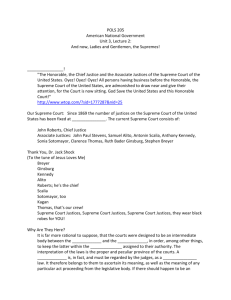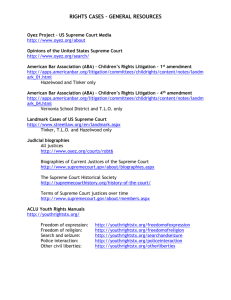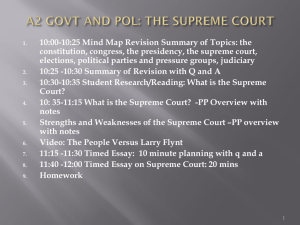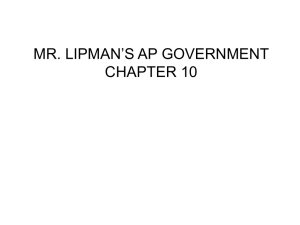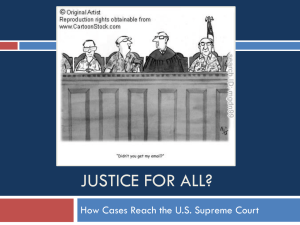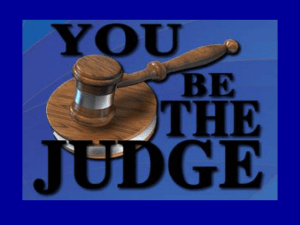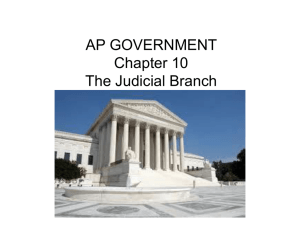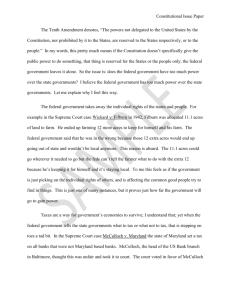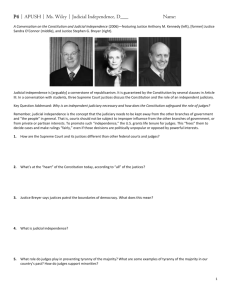the Supreme
advertisement
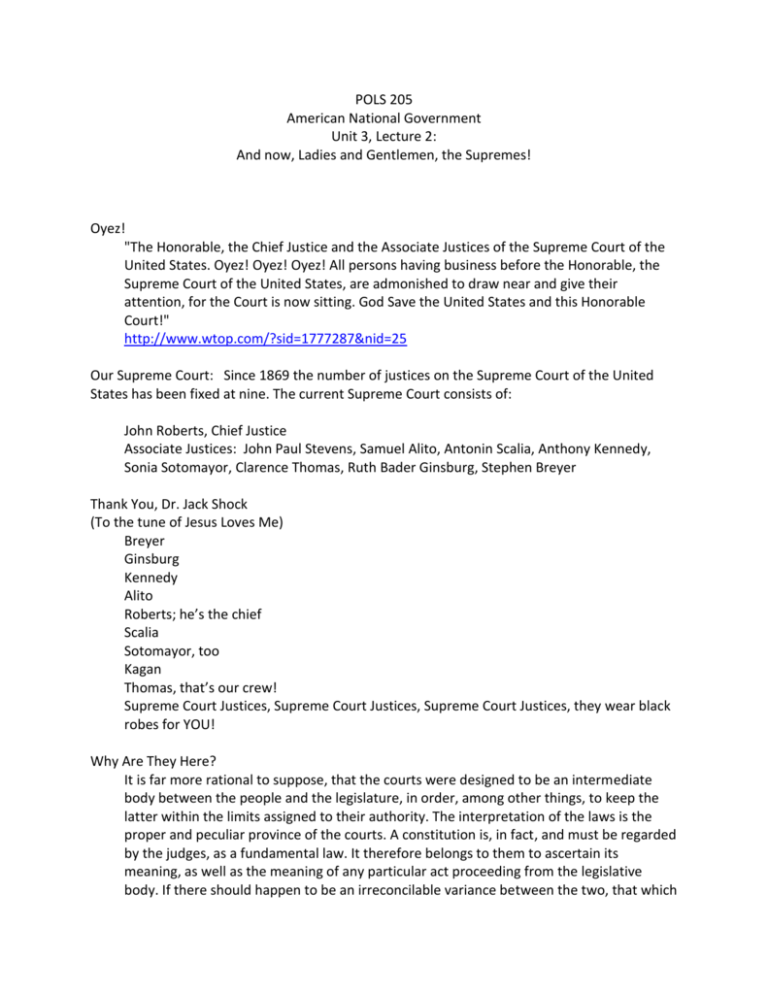
POLS 205 American National Government Unit 3, Lecture 2: And now, Ladies and Gentlemen, the Supremes! Oyez! "The Honorable, the Chief Justice and the Associate Justices of the Supreme Court of the United States. Oyez! Oyez! Oyez! All persons having business before the Honorable, the Supreme Court of the United States, are admonished to draw near and give their attention, for the Court is now sitting. God Save the United States and this Honorable Court!" http://www.wtop.com/?sid=1777287&nid=25 Our Supreme Court: Since 1869 the number of justices on the Supreme Court of the United States has been fixed at nine. The current Supreme Court consists of: John Roberts, Chief Justice Associate Justices: John Paul Stevens, Samuel Alito, Antonin Scalia, Anthony Kennedy, Sonia Sotomayor, Clarence Thomas, Ruth Bader Ginsburg, Stephen Breyer Thank You, Dr. Jack Shock (To the tune of Jesus Loves Me) Breyer Ginsburg Kennedy Alito Roberts; he’s the chief Scalia Sotomayor, too Kagan Thomas, that’s our crew! Supreme Court Justices, Supreme Court Justices, Supreme Court Justices, they wear black robes for YOU! Why Are They Here? It is far more rational to suppose, that the courts were designed to be an intermediate body between the people and the legislature, in order, among other things, to keep the latter within the limits assigned to their authority. The interpretation of the laws is the proper and peculiar province of the courts. A constitution is, in fact, and must be regarded by the judges, as a fundamental law. It therefore belongs to them to ascertain its meaning, as well as the meaning of any particular act proceeding from the legislative body. If there should happen to be an irreconcilable variance between the two, that which has the superior obligation and validity ought, of course, to be preferred; or, in other words, the Constitution ought to be preferred to the statute, the intention of the people to the intention of their agents. The Federalist #78, Alexander Hamilton What Do You Mean By Supreme? Nor does this conclusion by any means suppose a superiority of the judicial to the legislative power. It only supposes that the power of the people is superior to both; and that where the will of the legislature, declared in its statutes, stands in opposition to that of the people, declared in the Constitution, the judges ought to be governed by the latter rather than the former. They ought to regulate their decisions by the fundamental laws, rather than by those which are not fundamental. Federalist #78, Alexander Hamilton God Save This Honorable Court No Cases for the first 3 years! No Building until 1935 Fourth Chief Justice John Marshall (1801-1835) “found the Constitution paper and made it power” (Garfield) Dred Scott 1857 – Overturns an Act of Congress and sets the stage for WAR Roosevelt and the Court Packing Plan 1937-38 - Pack ‘em in Roosevelt tires of his popularly supported, Congressionally mandated programs being determined unconstitutional Proposes a bill to allow “up to 15” Justices; with a new appointment paired with any unretired justice over 70 years old The bill is defeated by a coalition of Republicans and Southern Democrats The ”switch in time saves 9” of 1937 (Justice Roberts shifts the 5-4 balance)– the Court defeats the President by giving him what he wants… In the end, Roosevelt has appointed 4 new judges in 3 years anyway He appoints 9 overall, the most of any president Recent Courts Warren Court 1953-1969 Biggest … mistake I ever made… (Eisenhower) Modern Activist Court Brown, Miranda, Baker v. Carr Burger Court 1969-1986 Moderate, Activist Court Roe v. Wade, Nixon Rehnquist Court 1986-2005 Conservative, Semi-Activist Court Texas v. Johnson, Bush v. Gore Roberts Court 2005-present Conservative, Restrained Court??? Hot Potato Nominations President Nominates; Senate Confirms (Art. II, S. 2 (2)) Why is this such a political “hot potato”? Because “only in the United States do judges play so large a role in making public policy” (James Q. Wilson) “Vacancy crisis” (694+179+9) Senatorial Courtesy 147 Justices submitted, 29 failed to be confirmed (7 in the last hundred plus years) “Borking”, paper trail, “litmus” tests And one more deadly important reason why… You Keep Me Hangin’ On The Judges, both of the supreme and inferior Courts, shall hold their Offices during good Behaviour (Article III, Section1) Judges serve for LIFE if they wish to! Work My Fingers to the Bone Term begins the “First Monday in October” Generally done by June or early July 8,000 petitions filed per term (plus 1,200 other applications) These days: around 80 cases actually heard each session Sittings: hear cases and deliver opinions 30 minutes to present each side Oral arguments and printed briefs Up to 24 cases per sitting Recess: consider court business and write opinions Sittings and recesses alternate in two week intervals http://www.supremecourtus.gov/oral_arguments/09TermCourtCalendar.pdf Don’t Make a Federal Case Out of It! Federal Question US Constitution Civil rights Treaty Federal law Diversity of Citizenship Parties of a lawsuit are from different states US citizen and a foreign entity (Rare) I Have Decided… Affirm Reverse (or Void) Remand You Say Tomato… Types of Opinions: Unanimous Majority Concurring Dissenting Per Curium – for the court http://www.supremecourtus.gov/opinions/08slipopinion.html Straight from the Home Office in Wahoo, Nebraska Marshall Court: Marbury v. Madison 1803 McCulloch v. Maryland 1819 Gibbons v. Ogden 1824 Taney Court Dred Scott v. Sanford 1857 Fuller Court: Plessy v. Ferguson 1896 And Harlan’s dissent Warren Court: Mapp v. Ohio 1961 Baker v. Carr 1962 Brown v. Board of Education 1954 Gideon v. Wainwright 1964 Miranda v. Arizona 1966 Burger Court: Roe v. Wade 1973 Nixon v. US 1974 UC v. Bakke 1978 Rehnquist Court: Bush V. Gore
